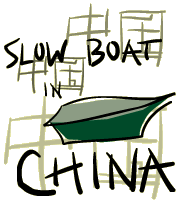LIVING & TRAVEL

by David Wallis

Each day, on the banks of the Yangtze River, a mushrooming army of laborers blasts and digs around the clock. They are creating the Three Gorges Dam, the world's largest hydro-electric project. When completed, the dam will generate a power source equivalent to ten nuclear plants while ending chronic flooding that threatens millions of people (almost eight percent of humanity lives in the Yangtze River watershed). At least that's what proponents say.
Critics see the project as little more than a political monument promoted by Deng Xiaoping and hardline Prime Minister Li Peng. Many believe that a series of smaller dams built on the Yangtze's tributaries could produce the same power for far less than the estimated thirty billion dollar price tag of the Three Gorges Dam.

WEB RESOURCES
Three Gorges Dam
Information about the Three Gorges Dam (definitely not from the local tourist board). Join the campaign to stop the dam here.
Victoria Cruises on the Yangtze River
$560 to $690 per person (4-6 days).
Earth River Expeditions
Raft the Yangtze River: $4,300 per person for 17 days, from San Francisco. Includes trips to Beijing ,Tibetan plateau, Tibetan villages and Lhasa.
Emperor's Cruise
China, Hong Kong, and Yangtze River : 19 Days for $ 3299 (East Coast), $ 3149 (West Coast).
Canadian Odysseys
Tours from Canada to the Yangtze River.
Photo Gallery
Pictures of the Yangtze River area.
Scores of foreign and Chinese engineers predict that silting above the dam will convert the upper Three Gorges into an un-navigable lake with the consistency of crude oil. Animal conservationists expect the project's environmental consequences will further endanger three threatened animals; the Yangtze sturgeon, white dolphin and giant salamander.
No one disputes that the impending flood will uproot more than a million people from their homes, and submerge thirteen cities. Fourteen towns. Over a thousand villages. Countless archaeological sites. And much of the Three Gorge's dramatic mountain scenery that many Chinese consider a national treasure. Imagine filling in the Grand Canyon.
Although construction should last well into the next century, the scheduled completion of a buffer dam will temporarily halt all river traffic by the Winter of 1997-1998. I wanted to witness the Three Gorges before its metamorphosis.
I board the Victoria II cruise ship in the sprawling coke town of Wuhan. Owned by a Chinese state shipping company and run by American marketers, the luxurious ship makes the 850 mile voyage upriver in five days. Our final destination will be Chunking, the largest city in Szechwan Province.
At first glimpse the Yangtze looks like a roiling cesspool bisecting a city of cranes. The water is the color of butterscotch, due to the millions of tons of sediment hitching a ride downstream.
Richard Hayman, a sinologist in Victoria's employ, assures me that the scenery improves upriver. He ushers me into the ship's Starlight Lounge for the welcome cocktail party -- an affair named as such because you welcome the cocktails and hope to forget the party. A pianist murdering "Unforgettable" competes with Chinese rock and roll playing over the sound system. About 40 tuxedoed waiters and bartenders pass flutes of sweet local champagne to half as many guests. After introducing of the senior crew members, Captain Li grabs the microphone to toast his guests. He is an Asian John Belushi wearing a creased white uniform with a porcupine for a hairpiece. After the ceremonies I corner the chunky Captain and ask his position on the dam.

Before excusing himself he remarks, "This is a very dangerous river." It is said that "the path to Szechwan is more difficult than the climb to heaven." Powerful currents, whirlpools, eddies and needle-like passages -- in some places only sixty yards wide -- frustrate navigation. Points on the river are unfathomable, while others are perilously shallow. Overcrowded shipping lanes add to the danger. Our ship often finds itself sandwiched between colossal freighters hauling mounds of coal and local water-taxis ferrying a farmer and his cow. Since China's lunge toward a free market economy, traffic has intensified as legions of independent fisherman set sail in all kinds of patchwork vessels/bathtubs; some so tiny they are known as "water shoes."
Shortly after the revolution, the Chinese government aided navigation by dredging shallows and dynamiting rocks that were blamed for countless wrecks. Before the blasting, the trip upriver required the aid of trackers. These human burros tied themselves together and dragged junks slowly against the current. If a tracker tripped and dangled off a cliff, his compatriots would sever the line. It was an unwritten rule. John Hersey provides an account in the novel, "A Single Pebble": "It was ... horribly depressing to see more than 300 human beings reduced to the level of work animals, blindfolded asses and oxen, yet thrilling to see the irresistible force of their cooperation for ... each step up the slope was planted in the same moment, and the sad trackers cries 'Ayah, Ayah' were sung in unison in a great choir of agony and joy and the junk did move."
Through clouds of mist, I can follow the trackers' paths etched into the moss-covered mountains after we enter Xiling Gorge, the first of the famed ravines. Along with several ornate pagodas and stone temples that we pass, evidence of trackers will soon be buried under hundreds of feet of water. I know we're approaching the dam site by the echo of metal hitting metal. It is a complex of tents and tractors framed by banners hanging off the granite cliffs that read "CONSTRUCT THE THREE GORGES DAM -- DEVELOP THE YANGTZE RIVER."

Although a few locals complain about leaving their homes and ancestors behind, most people I speak with sort of shrug their shoulders and give a "You gotta go when you gotta go" reaction to their upcoming departure. One man selling ceramic dragons voices support for the project. "It will reduce floods that have killed many people," he says. "Moving is not a big price to pay."
The next morning we leave the ship for an excursion along the Daning River, one of the Yangtze's tributaries. We stop for lunch in Double Dragon Village, a place that makes Wushan look like a metropolis. Our arrival draws a crowd of beggars and a woman who try to sell us plastic bags of plums, various vegetables and polished black rocks from nearby shores. One young mother hoists her baby in the face of a woman from New York. She asks the New Yorker to bring her baby back to the US. I am glad when we return to the ship.
We set sail and near the last canyon. Sharp bends in the mist-blanketed river fool my eyes. The river's path appears to end, but on closer inspection just turns a corner and lives up to its Chinese name "Chang Jiang," or "Long River." Richard Hayman knows each turn and joyfully tells us the legend behind each weathered peak. "Gold Headgear and Silver Armor Peak" resembles a warrior in full battle costume, and "Shennu Peak" personifies Goddess Yaoji, who welcomes the sun each morning.
I ask Hayman for his thoughts on the dam. "It will either be the greatest engineering feat in Chinese history or the greatest man-made disaster ever," he says, grinning. "Of course, the whole area could be turned into an underwater amusement park for divers." Visibility, however, might pose a problem.
David Wallis has written for the New York Times, Esquire and George.
